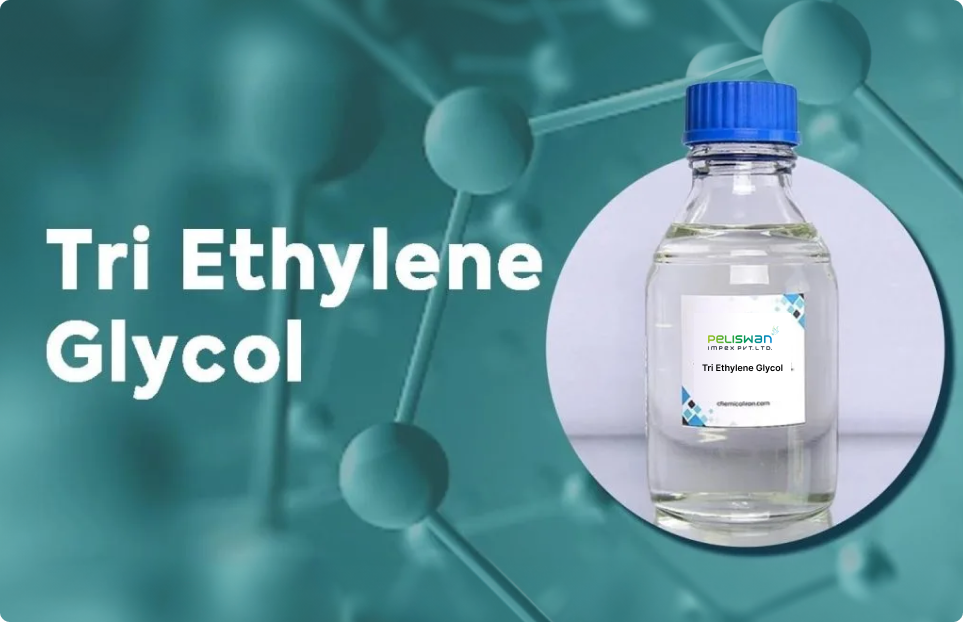
June 26, 2024
Unlocking the Magic of Tri ethylene Glycol
Triethylene glycol (TEG), often abbreviated as TEG or triglycol, might sound like a complex scientific term, but its applications touch our daily lives in surprising ways. This colorless, odorless liquid with a slightly sweet taste possesses a unique set of properties that make it a valuable player in various industries. Let’s delve into the TEG, exploring its properties, applications, current technologies, and future outlook.
Unveiling the Chemical and Physical of TEG
Triethylene Glycol, with the chemical formula C6H14O4, a molecular weight of TEG is 150.2 g/mol. It possesses a high boiling point, ensuring it remains stable at high temperatures. However, TEG also has a surprisingly low freezing point of, making it suitable for various applications.
One of its most valuable traits is its miscibility with both water and many organic solvents, offering versatility in different environments. Furthermore, TEG is hygroscopic, meaning it readily absorbs moisture from the surrounding air. This property makes it a great dehydrating agent. The final piece of the magic puzzle is TEG’s low volatility.
With a low vapor pressure, TEG has a minimal tendency to evaporate, reducing potential losses during handling and use. These combined properties make TEG a highly valuable and versatile chemical for a wide range of applications.
Traditional Applications: The Workhorse of Industry
TEG has a long history of industrial applications, playing a crucial role in:
Natural Gas Processing: TEG is the workhorse in dehydrating natural gas, removing water vapor that can cause pipeline freezing and corrosion. The water-loving nature of TEG allows it to capture moisture, leaving behind dry, clean natural gas for transportation and consumption. (Image of Natural gas processing plant)
Antifreeze and Coolant: Similar to its cousin ethylene glycol, TEG can be used in antifreeze formulations for industrial applications, preventing freezing in cooling systems.
Plasticizer: TEG enhances the flexibility and workability of various materials like polyvinyl chloride (PVC) plastics, making them more manageable during processing.
Heating, Ventilation and Air conditioning (HVAC):Due to its low volatility, TEG is used as a heat transfer fluid in industrial heating and cooling systems. Its hygroscopic nature makes it useful for controlling moisture in refrigerants and preventing corrosion in HVAC systems.
Pharmaceutical and Cosmetic Application: TEG is used as a solvent and stabilizer in pharmaceutical liquid formulations like oral suspensions and cough syrups. It is also used in cosmetic and personal care products due to its skin-conditioning properties.
These traditional applications showcase TEG’s effectiveness in various industrial sectors.
Emerging Applications: Pushing the Boundaries
Lithium-ion Battery Electrolytes: With the rise of electric vehicles, TEG is being explored as a potential component in lithium-ion battery electrolytes. Its ability to conduct electricity and dissolve battery salts makes it a candidate for further research.
Desiccant for Air Drying: TEG’s hygroscopic nature makes it suitable as a desiccant in industrial air drying applications, removing moisture from compressed air systems to prevent equipment corrosion.
Pharmaceutical Manufacturing: TEG can be used as a solvent in the production of certain pharmaceuticals, aiding in the dissolution of various ingredients.
Softening Agent: TEG is used as a softening agent for tobacco, paper, synthetic sponges, glues, and casein.
These emerging applications demonstrate the ongoing exploration of TEG’s potential in various fields, paving the way for its continued relevance in the future.
Traditional and New Technologies: Optimizing the Magic
Traditional Technology: The Amine Scrubbing Process: The dominant method for TEG production relies on the amine scrubbing process. In this process, ethylene oxide reacts to form ethylene glycol, which is then further reacted to obtain TEG. While established, this method can generate byproducts that require careful management.
Emerging Technology: Bio-based TEG Production: Researchers are exploring the production of TEG from renewable resources like biomass. This method utilizes fermentation processes to convert plant-derived materials into TEG, offering a more sustainable alternative to traditional methods.
New Separation Technologies: Efficient separation techniques are crucial for purifying TEG after dehydration processes in natural gas processing. New technologies like membrane separation are being explored to improve efficiency and reduce energy consumption.
These advancements show the continuous efforts to optimize TEG production and utilization.
Future Outlook and Market Trends
The future of TEG appears promising, driven by several factors:
Growing Demand for Natural Gas: As the global demand for natural gas continues to rise, TEG will remain essential for dehydration processes in the natural gas industry.
Focus on Sustainability: The development of bio-based TEG production methods and cleaner separation technologies aligns with the growing emphasis on sustainability in the chemical industry.
Emerging Applications: The ongoing exploration of TEG’s potential in areas like battery electrolytes and air drying holds promise for a more diversified market.
The current TEG market is expected to witness steady growth in the coming years, with the Asia Pacific region being a major driver due to increasing industrial activity.
Overall, TEG’s unique properties and diverse applications ensure its continued relevance in various industries. With a focus on sustainable production methods and innovative applications, the future of TEG seems bright, unlocking its magic for generations to come.


